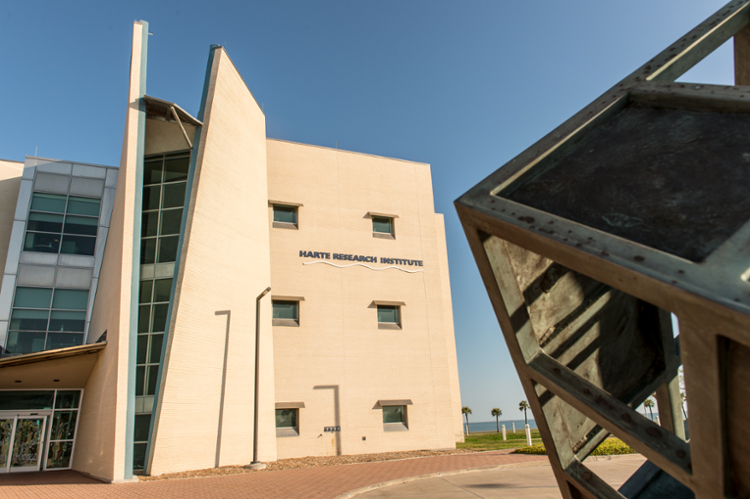Harte Research Institute Study Finds Coastal Bend Red Tides Increasing, May be Tied to Salinity Increases
CORPUS CHRISTI, Texas – Red tide, the dreaded Gulf algal blooms that can cause fish kills and release aerosolized toxins that irritate our eyes, skin and respiratory systems, are occurring in Coastal Bend bays with increasing frequency, according to a new paper from Harte Research Institute for Gulf Studies (HRI) at Texas A&M University-Corpus Christi doctoral candidate Sarah Tominack.
Tominack worked with decades of data from state environmental agencies and historic reports from the Corpus Christi Caller-Times to piece together patterns of red tide occurrences and compared it to environmental data collected over the same period. Tominack teamed up with HRI Research Associate Kara Coffey, who dove into the archives of the Caller-Times for months at a time to dig up old reports of red tide on the Texas Coast, and build and database of reports on the phenomenon. Coffey’s own master’s research focused on public communications about red tide and the public’s perception of that risk.
The findings suggest that not only are red tides increasing in the Corpus Christi area, but they may be tied to documented long-term increases in salinity levels in the Nueces Estuary system. They were also less frequent during El Niño years when rainfall is higher in the region.
“With all of the damming that has occurred in the watershed, we have now essentially turned the bay into an arm of the ocean. The bay now appears to be much more habitable for red tide than it used to be when it was fresher,” said HRI Chair for Coastal Ecosystem Processes and co-author Dr. Michael Wetz.
The paper, “An assessment of trends in the frequency and duration of Karenia brevis red tide blooms on the South Texas coast (western Gulf),” was published in the journal PLOS ONE and includes fellow HRI co-authors Coffey; HRI Senior Executive Director Dr. David Yoskowitz; HRI Associate Director Gail Sutton; and Wetz, who serves as Tominack’s advisor.
The research was funded by a grant from the Office of the Governor administered by the Texas OneGulf Center for Excellence research consortium, which was created after the Deepwater Horizon oil spill to direct funding in support of programs, projects, and activities that restore and protect the environment and economy of the Gulf Coast region.
“It’s really important to study what is allowing these red tides to survive,” Tominack said. “The transportation of these cells is a big factor because when they get back in these bays and proliferate, they’re so much closer to humans, and that causes a much bigger impact.”
Red tide is made up of naturally occurring, microscopic algal cells that can multiply out of control to form what is called a harmful algal bloom. Locally they’re caused by the species Karenia brevis – which not only kill fish but also marine mammals, birds, turtles, and can affect humans, closing beaches and other nearshore areas.
High enough concentrations abloom will release a toxic aerosol. The most common symptoms in people include watery eyes, coughing, respiratory problems, sore throat, and skin irritation. People with asthma are particularly vulnerable and can suffer respiratory distress that sends them to the hospital. Even healthy people should not go into water in the vicinity of a red tide bloom.
These strong impacts on coastal environments and human populations are what make red tide easy to track in the historical record – their effects are notable and trigger strong curiosity.
Coffey dug into the historical archive of the Corpus Christi Caller-Times dating back to the 1950s to get a picture of red tide recurrence along the Coastal Bend area that spanned decades before the state was collecting regular data on the harmful algal blooms. Regular agency monitoring of red tides was not done until the 1990s, with some spotty data dating back to the 1980s – so the best way to understand the phenomenon was studying news mentions.
Tominack said it was interesting to see how newspapers documented the phenomenon over time, from small blips in coverage to several stories per day during a major Corpus Christi bloom in 1986 that spanned months and killed millions of fish.
Studying historical documents to get a better picture of human interactions with the environment, including newspaper articles, ship’s logs, and even menus, has been an emerging field in marine ecology in recent years, Tominack said. It allows scientists to piece together a picture of what fisheries may have looked like when a scientific record doesn’t exist – for example, to reconstruct the historic range of a certain species.
By studying the patterns of red tide in the Coastal Bend over time we can better learn what triggers their explosive growth, Tominack said. That could allow scientists to predict when red tides might occur based on environmental conditions, or even figure out ways to curb them.
“With knowledge of these conditions, we could even come up with a forecasting system – that would help people be prepared,” Tominack said.









